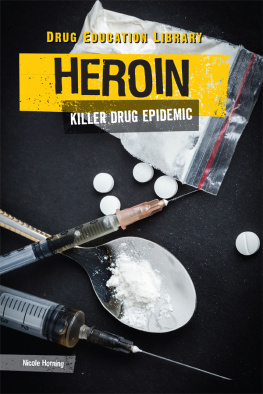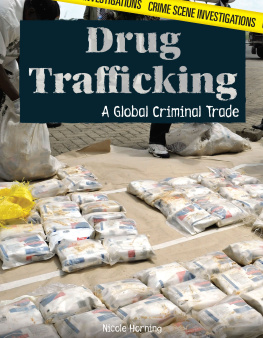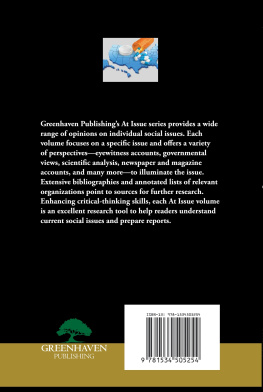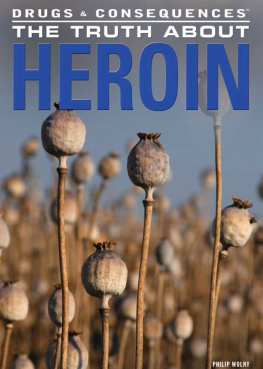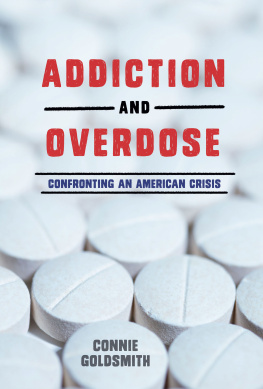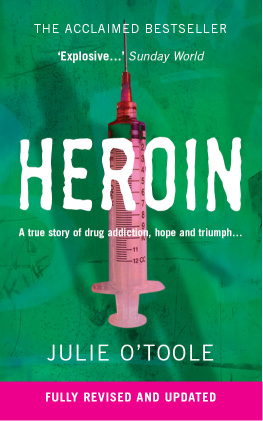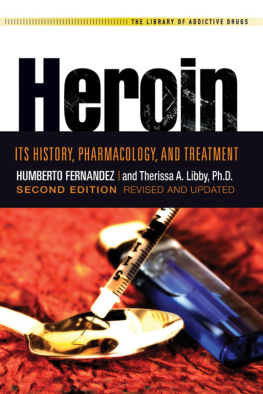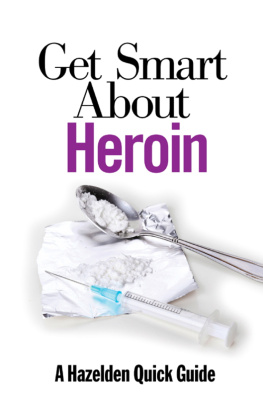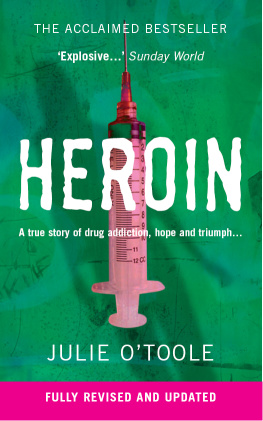Published in 2017 by
Lucent Press, an Imprint of Greenhaven Publishing, LLC
353 3rd Avenue Suite 255
New York, NY 10010
Copyright 2017 Lucent Press, an Imprint of Greenhaven Publishing, LLC.
All rights reserved. No part of this book may be reproduced in any form without permission in writing from the publisher, except by a reviewer.
Designer: Seth Hughes
Editor: Katie Kawa
Cataloging-in-Publication Data
Names: Horning, Nicole.
Title: Heroin: Killer drug epidemic / Nicole Horning.
Description: New York : Lucent Press, 2017. | Series: Drug education library | Includes index.
Identifiers: ISBN 9781534560093 (library bound) | ISBN 9781534560109 (ebook) Subjects: LCSH: Heroin--Juvenile literature. | Heroin abuse--Juvenile literature. | Drug abuse--Juvenile literature.
Classification: LCC HV5822.H4 H67 2017 | DDC 616.8632--dc23
Printed in the United States of America
CPSIA compliance information: Batch #CW17KL: For further information contact Greenhaven Publishing LLC, New York, New York at 1-844-317-7404.
Please visit our website, www.greenhavenpublishing.com . For a free color catalog of all our high-quality books, call toll free 1-844-317-7404 or fax 1-844-317-7405.
Foreword
T he development of drugs and drug use in America is a cultural paradox. On the one hand, strong, potentially dangerous drugs provide people with relief from numerous physical and psychological ailments. Sedatives such as Valium counter the effects of anxiety; steroids treat severe burns, anemia, and some forms of cancer; and morphine provides quick pain relief. On the other hand, many drugs (sedatives, steroids, and morphine among them) are consistently misused or abused. Millions of Americans struggle each year with drug addictions that overpower their ability to think and act rationally. Researchers often link drug abuse to criminal activity, traffic accidents, domestic violence, and suicide.
These harmful effects seem obvious today. Newspaper articles, medical journals, and scientific studies have highlighted the many problems drug use and abuse can cause. Yet, there was a time when many of the drugs now known to be harmful were actually believed to be beneficial. Cocaine, for example, was once hailed as a great cure, used to treat everything from nausea and weakness to colds and asthma. Developed in Europe during the 1880s, cocaine spread quickly to the United States, where manufacturers made it the primary ingredient in such everyday substances as cough medicines, lozenges, and tonics. Likewise, heroin, an opium derivative, became a popular painkiller during the late 19th century. Doctors and patients flocked to American drugstores to buy heroin, which was described as the optimal cure for even the worst coughs and chest pains.
As more people began using these drugs, though, doctors, legislators, and the public at large began to realize that they were more damaging than beneficial. After years of using heroin as a painkiller, for example, patients began asking their doctors for larger and stronger doses. Cocaine users reported dangerous side effects, including hallucinations and wild mood shifts. As a result, the U.S. government initiated more stringent regulation of many powerful and addictive drugs, and in some cases outlawed them entirely.
A drugs legal status is not always indicative of how dangerous it is, however. Some drugs known to have harmful effects can be purchased legally in the United States and elsewhere. Nicotine, a key ingredient in cigarettes, is known to be highly addictive. In an effort to meet their bodys demand for nicotine, smokers expose themselves to lung cancer, emphysema, and other life-threatening conditions. Despite these risks, nicotine is legal almost everywhere.
Other drugs that cannot be purchased or sold legally are the subject of much debate regarding their effects on physical and mental health. Marijuana, sometimes described as a gateway drug that leads users to other drugs, cannot legally be used, grown, or sold in half of the United States. However, some research suggests that marijuana is neither addictive nor a gateway drug and that it might actually have a host of health benefits, which has led to its legalization in many states for medical use only. A handful of states also permit it to be used recreationally, but the debate on this matter still rages.
The Drug Education Library examines the paradox of drug use in America by focusing on some of the most commonly used and abused drugs or categories of drugs available today. By objectively discussing the many types of drugs, their intended purposes, their effects (both planned and unplanned), and the controversies surrounding them, the books in this series provide readers with an understanding of the complex role drugs play in American society. Informative sidebars, annotated bibliographies, and lists of organizations to contact highlight the text and provide young readers with many opportunities for further discussion and research.
Introduction
HEROIN: THE EVOLUTION OF AN EPIDEMIC
F lowers are generally grown in a garden or bought in a store to give to someone you care about. However, certain varieties of poppy flowers are used for something much more sinister. The papaver somiferuma type of poppy floweris where the production of heroin begins. From this brightly colored flower comes one of the most dangerous drugs in the world and one that is at the center of an epidemic, or deadly outbreak. Thousands die each year from the heroin that is derived from this poppy flower, and it is a rate that is not slowing. In fact, the death toll from heroin has surged since 2010. According to the United States Drug Enforcement Administration (DEA), deaths involving heroin more than tripled between 2010 (3,036) and 2014 (10,574)a rate faster than other illicit drugs.1
Tackling this deadly epidemic starts with understanding it how it began, how it developed, and, most importantly, the dangerous effects of this drug that extend far beyond coming down from the high. Heroin has a long and complicated history from the cultivation of the opium poppy in Mesopotamia in 3400 BC to the appearance of opiums refined form of heroin in the late 1800s. Originally used to treat addictions, heroin became the object of addiction itself. Heroin addiction has seen a number of surges. It all began with the first rise in addiction rates in the early 1900s to the development of the black market (illegal trade) and illegal street dealers in the 1920s after the passage of the Harrison Narcotics Act. Eventually, these addiction rates elevated to epidemic proportions in Vietnam during the Vietnam War. Today, heroin addiction has become a matter of national concern, and officials are looking to new, unconventional ways to tackle the epidemic and save thousands of lives.
Heroisch: The Beginning
Opium was at the center of discussions about addiction as early as the 1800s. The use of opium was often confined to opium dens, where addicts could smoke this drug. At the height of the opium craze, the dependence and addiction to it was such that 22,000 pounds (9,979 kg) of opium was imported from Turkey and India to Britain.
From this addictive drug, another addictive, yet helpful drug can be refinedmorphine. In 1803, Friedrich Sertuerner discovered the active ingredient of opium by dissolving it in acid then neutralizing it with ammonia,2 the result of which was morphine. Morphine is still in use today for pain relief from things such as surgery, and this drug is much more powerful than processed opium. In fact, it is 10 times more powerful than the opium it is derived from.

